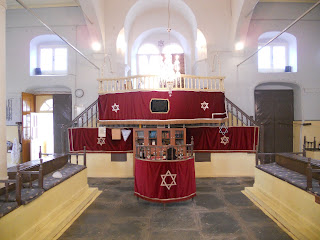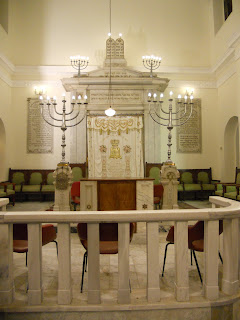We left the lovely little town of Delphi at 8 in the morning and we made a short stop in Chalkida for the morning. We visited a shul that burned down 7 times throughout its history, but has been rebuilt each time with its original columns which date back to the 5th or 6th century CE. The only texts that survived the most recent fire in 1846 were 3 Torahs, one dating back to 15th century and another to the 13th century.
The Jewish community in Chalkida is one of the oldest surviving communities. A group of Jews came to Chalkida after the destruction of the first temple in 586 BCE. Fast forward to WWII, and only 18 Jews were killed by the Nazis because Metropolitan Gregorious wrote his name over and over again on the list of Jews, which bought the Jews time to flee into the mountains. We had lunch then made our way to Athens, where went to the Parthenon museum. We had a nice kosher dinner at the Chabad in Athens and then got some rest before our extremely long day.
Our last day was a fitting end to an amazing first trip. We began the day the with our tour of the acropolis, which is the hill in the middle of Athens with the ancient ruins on top. The ruins, or the Parthenon, was the temple of Athena, but it wasn't used for religious purposes. Pericles, the Parthenon's "project manager," built it simply for aesthetic purposes.
I asked our tour guide how long it took to finish one column, because their ability to build something so magnificent, huge, and detailed over 2,500 years ago did and still does perplex me. She told us that one column took 19,000 work hours, which is equivalent to the same amount of time it takes to complete an apartment building today.
People may not realize that there are more buildings on the acropolis that actually had more value while they were in use. For example the Erechtheion, according to the Parthenon museum wall, contains evidence that the gods visited the cite because Poseidon hit a rock in that same spot and a well sprouted.
The views from the acropolis were incredible. We could see the entire city of Athens, but my pictures don't really capture the beauty of the views that you see in person. Possibly my best picture is the one where I tried to capture the ancient agora, which is an open square in the center of the town which was a popular public place to hang out.
(The green area is the ancient agora)
After our visit to the Parthenon we went to the Jewish museum of Athens, but I have to be honest, the Parthenon is a tough act to follow and it was difficult to really get into the zone and enjoy the museum. After our visit to the museum we went to Lycabettus Mountain, the highest point in Athens with views that are even better than the acropolis, to eat lunch.
We ended our trip with a meeting with the Chief Rabbi of Athens Issak Dayan, who told us his personal story about his experience during WWII. I really wish I could remember it, but I was dazing in and out. You know the times when you're so exhausted that your eyelids literally feel like they're 500 pounds and you just can't do anything to keep them open no matter how hard you try? Well that's what I was unfortunately going through while the Rabbi was talking.
After our meeting with Rabbi Dayan we were let loose in the Athens equivalent of Ben Yehuda Street, but with better and more expensive stores and restaurants. Me, Mina, and 3 of our other friends enjoyed a lovely Thanksgiving dinner in an Italian restaurant in Greece. Afterwards we got delicious frozen greek yogurt which was the cherry on top of a wonderful dinner, a wonderful day, and a wonderful trip.
You can also see a map of everywhere we went here:
https://maps.google.com/maps/ms?msid=205070434549703180777.0004cf31e0a933580cad5&msa=0
4 down, 8 to go.




























